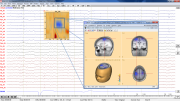BESA Research
BESA Research 6.1
Choose the best signal processing for your EEG and MEG data
BESA is the most widely used software for source analysis and dipole localization in EEG and MEG research. BESA Research has been developed on the basis of 30 years experience in human brain research by the team around Michael Scherg, University of Heidelberg, and Patrick Berg, University of Konstanz.
BESA Research is a highly versatile and user-friendly Windows® program with optimized tools and scripts to preprocess raw or averaged data for source analysis and connectivity analysis. All important aspects of source analysis are displayed in one window for immediate selection of a wide range of tools. The same holds true for the source coherence / time-frequency module, and other analysis windows. BESA Research provides fast and easy hypothesis testing, a variety of source analysis algorithms including cortical imaging and volume imaging methods, integration with MRI and fMRI, age-appropriate template head models (FEM) as well as the possibility to import individual head models (FEM) generated by BESA MRI 2.0.
Source coherence, a unique feature for viewing brain activity
BESA Research transforms surface signals into brain activity using source montages derived from multiple source models. This allows displaying ongoing EEG/MEG, single epochs, and averages with much higher spatial resolution.
The Source Coherence Module provides an extremely fast and user-friendly implementation of time-frequency analysis based on complex demodulation. Users can create event-related time-frequency displays of power, amplitude, or event-related (de)synchronization and coherence for the current montage using brain sources or surface channels. Induced and evoked activities can be separated. Source coherence analysis reveals the functional connectivity between brain regions by reducing the volume conduction effects seen in surface coherence. Users can select a time-frequency window for (bilateral) beamformer and dynamic imaging of coherent sources (Gross et al., PNAS 2001).
More than just dipole source localization
BESA Research covers the whole range of signal processing and analysis from the acquired raw data to dynamic source images:
- Data review and processing
- Source montages and 3D whole-head mapping
- ERP analysis and averaging
- Source localization and source imaging
- Individual MRI and fMRI integration with BESA MRI and BrainVoyager
- Source coherence and time-frequency analysis
Upcoming new features in BESA Research 7.0
BESA Research 7.0 sets new standards in several aspects of neurophysiological data analysis: Welcome to the most streamlined and comprehensive analysis package available for state-of-the-art research using human EEG and MEG data! Particular highlights of the new feature list include:
Connectivity analysis
• Stand-alone module with 64-bit architecture and modern workflow design
• Use wavelets and / or complex demodulation
• Analyze connectivity in source space or sensor space
• Latest connectivity methods including Granger Causality, Partial Directed Coherence, …
• Visualize data in clear 2D and 3D result plots and create publication images or videos
• Seamless integration with BESA Research
• Export results for further analysis in e.g. BESA Statistics
Simultaneous EEG-fMRI imaging
• Correct your fMRI artifacts directly in the BESA Research review window
• Choose between three proven methods for correction with few mouse clicks
• Read your fMRI data directly into BESA Research
• Seed sources from fMRI and directly see activation patterns on millisecond scale
Beamforming
• Time-domain beamformer using one of several state-of-the-art methods
• Virtual sensor mode to reconstruct time courses
• Source montages using the beamformer spatial filter can be applied to raw data
• Compute beamformer image for any time point in interval of interest
• Conveniently select beamformer intervals graphically in ERP module
Bayesian source imaging
• Sequential Semi-Analytic Monte-Carlo Estimation (SESAME) of sources
• Automatically find most likely number of sources
• Compute map of likelihood for source positions
• Choose between most likely solutions for different numbers of sources
• Virtually no user input required
• Uses Markov-Chain Monte-Carlo method for efficient computation of probability distribution
Brain atlases
• Check the anatomical or functional brain regions of your source imaging or dipole fitting results
• Seed sources from known locations in the brain atlas
• Choose between several state-of-the-art atlases including AAL, Brainnetome, Brodmann, …
• Visualize source imaging results together with atlas images
• Innovative contour display mode to facilitate brain image review





